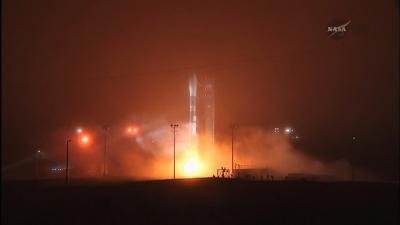Spacecraft Intended To Measure Carbon Dioxide Levels From Space
A Delta II rocket blazed off the launch pad at Vandenberg Air Force Base in California early Wednesday morning to begin a landmark mission to survey carbon dioxide gas in Earth's atmosphere.

NASA's Orbiting Carbon Observatory-2, or OCO-2, is expected to provide insight into how the planet adjusts to the increased production of carbon dioxide from a vantage point in orbit that will allow it to take readings on a scale never achieved before.
While ground stations have been monitoring carbon dioxide concentrations, OCO-2 will be the first spacecraft to conduct a global-scale reading over several seasons. The spacecraft is expected to produce detailed readings to provide regional sources of carbon dioxide as well as sinks for the greenhouse gas.
"There's quite a lot of urgency to see what we can get from a satellite like OCO-2," said David Crisp, the science team lead for the mission.
The spacecraft flew into orbit aboard a United Launch Alliance Delta II rocket launched from Vandenberg Air Force Base in California. The July 2 liftoff came at 0556 Eastern time, 0256 Pacific time.
The launch was from the west coast so the spacecraft could enter a polar orbit of the Earth, a flight path that will see it cross over the Arctic and Antarctic regions during each revolution and get a complete picture of the Earth. It will fly about 438 miles above the planet's surface to take its readings. "The only way to accomplish a polar orbit from U.S. soil is to launch from Vandenberg," said Tim Dunn, NASA's launch manager for the flight.
The mission is the first of its kind in the agency's extensive history of Earth-observing spacecraft. The spacecraft was launched to replace the first OCO that did not make it into orbit due to an anomaly in February 2009. The spacecraft carries one instrument and its sole focus is detecting carbon dioxide and watching from space as the Earth "breathes" to see what becomes of the gas.
The instrument is precise enough that researchers will be able to count the number of carbon dioxide molecules in the layers of the atmosphere and use the data to draw conclusions about how the increasing amount of gas will affect things like the global temperature. OCO-2's mission is to last at least two years.
NASA's Launch Services Program, based at Kennedy Space Center in Florida, managed the launch preparation and flight into orbit. The OCO-2 mission is handled by the Jet Propulsion Laboratory in California. "We've been preparing for the OCO-2 mission for almost two years now," Dunn said before launch. "The biggest challenge has been in bringing the Delta II launch vehicle out of retirement. The last time we launched on a Delta II was October 2011, a weather satellite."
With the mission safely begun, Dunn congratulated the team soon after OCO-2 separated from the Delta II's second stage and opened its pair of solar array wings.
(Image provided by NASA)
 ANN's Daily Aero-Term (04.25.24): Airport Rotating Beacon
ANN's Daily Aero-Term (04.25.24): Airport Rotating Beacon ANN's Daily Aero-Linx (04.25.24)
ANN's Daily Aero-Linx (04.25.24) Klyde Morris (04.22.24)
Klyde Morris (04.22.24) Airborne 04.24.24: INTEGRAL E, Elixir USA, M700 RVSM
Airborne 04.24.24: INTEGRAL E, Elixir USA, M700 RVSM Airborne 04.22.24: Rotor X Worsens, Airport Fees 4 FNB?, USMC Drone Pilot
Airborne 04.22.24: Rotor X Worsens, Airport Fees 4 FNB?, USMC Drone Pilot



